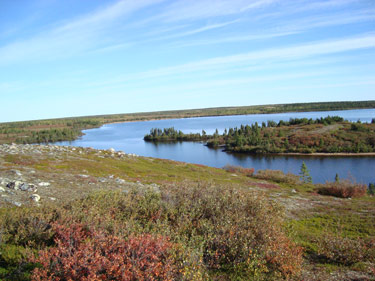Nueltin Lake Provincial Park
Northeast Parks

Nueltin Lake Provincial Park was established in 2010 and is located in north west Manitoba. This 4472 km2 park protects the wilderness in the northern transition natural region which lies between the boreal forest and tundra regions. The park shares its name with Nueltin Lake, the largest water body in the area. The southern third of Nueltin Lake is located in Manitoba with the remainder part of Nunavut. The lake is characterized by a varied shoreline and numerous islands. The Thlewiaza River system drains the majority of the Nueltin Lake area flowing into Hudson Bay through Nunavut. The park area lies within the discontinuous permafrost zone. Permafrost is primarily associated with bog peatlands, which are widespread throughout the area.
Eskers as high as 50 metres dominate the landscape in this park. At 190 kilometres long, the Roberston Esker is the longest continuous esker in Manitoba and crosses the southeast portion of Nueltin. Eskers provide the main travel corridor in the area for both wildlife and human visitors. Archeological evidence of pre-contact camps have been found on the eskers near water ways within the park.
Nueltin Lake Provincial Park protects a vast landscape relatively undisturbed by recent human developments. The park is within the range of the Beverly and Qamanirjuaq Barren Ground Caribou herds which are vulnerable to disturbances on the landscape. It is also an important summer breeding grounds for migratory birds. Several species of conservation concern as listed by the Committee on the Status of Endangered Wildlife in Canada and under the Endangered Species Act of Manitoba benefit from the park including the common nighthawk (listed as Threatened), and the rusty blackbird (listed as Special Concern). Recently barren ground grizzly bear (listed as Extirpated) have been sighted in lands adjacent to the park. Several provincially rare plants are also found in the park including sedge, spiked wood thrush and two species of reed grass. A provincially rare fish species, the threespine stickleback is found within the park boundaries.
There are no facilities located on park land, however a popular lodge is located on the lake in an area excluded from park designation. This makes the park popular for fly-in fishing to catch lake trout and northern pike. The park also receives a small number of visitors who use the park for wilderness canoeing. The park is designated for wilderness camping - there are no designated campsites and visitors are expected to camp at an existing site. The park is not road accessible and visitors must make alternate arrangements to visit.
The park is within the traditional territory of Northlands Denesuline First Nation and Sayisi Dene First Nation who continue to use this area for hunting, trapping and fishing.


